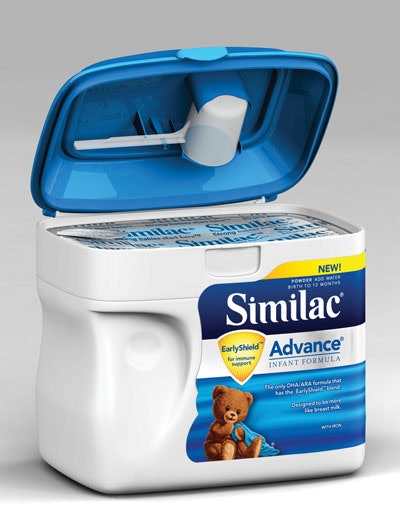
According to a report from Global Industry Analysts, Inc. (www.strategyR.com), “Plastics have increasingly replaced traditional materials such as paper and glass in conventional applications based on their cost benefits, superior functionality, convenience, barrier-resistance, and aesthetic appeal.”
For Abbott Nutrition, Columbus, OH, the switch from a round, composite can to a custom-engineered, extrusion blow-molded container for its infant formula resulted in a package that the company describes as “parent-friendly,” “easy-to-use,” “convenient,” and “mess-free.”
The new Similac® SimplePac™, launched nationally in August, represents a complete rethinking of Abbott’s infant formula package, says company spokesperson Carolyn Valek. “The Similac team conducted extensive research with more than 1,600 moms to understand how to make formula preparation easier,” she explains.
The resulting compact, high-density polyethylene container, in a 23.2- and 34-oz size, includes a number of unique features designed expressly for convenience. The bottom of the package has rounded corners that are said to match exactly the shape of the complementary plastic formula scoop “to help moms and dads get every last bit of formula,” Valek explains. A wide, rectangular opening at the top of the container makes scooping out the formula easier, while a deep concave area with a thumb hold on the front and back of the package allows for a one-hand grip.
Valek says the manufacture of the container by a proprietary supplier was made more challenging by the package’s unusual shape. “Its asymmetric design, coupled with the nonround opening, required a high level of development and the use of unique technology,” she says.
Facilitating use by Spanish-speaking consumers, the container uses an extended-text peel-back label printed with preparation instructions in Spanish, along with additional product information. Color-coding on the labels also helps consumers to easily identify the right formula for their child from among the seven Similac varieties offered.
Abbott also engineered the container’s blue plastic lid to solve other ease-of-use problems associated with traditional infant formula packaging. First, it attaches to the container with a hinge, making it easy for consumers to flip the lid open and shut, and eliminating misplaced lids. It also latches securely closed, enhancing the package’s portability in a diaper bag. And, tabs on the inside of the lid hold the formula scoop in place, so that consumers no longer have to fish though the powdery product to find the scoop before formula preparation.
“Consumer response to the product has been overwhelmingly positive,” Valek says, adding that retailers appreciate the fact that product pricing per ounce has stayed the same, despite the package change. The suggested retail price for the product ranges from $19.99 to $33.35.


















